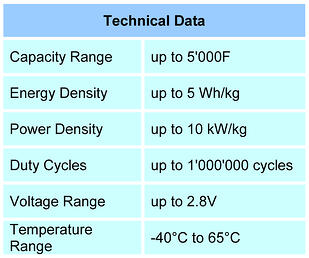What are Super Capacitors?
Published by
Lisa Hickey
on
A Super Capacitor is an electrochemical component that will lead electrical energy storage into a new dimension. Super Capacitor cells are able to fill the gap between conventional capacitors and batteries by providing high power performance in a compact design. A Super Capacitors’ strength is its ability to charge and discharge within seconds without damage and without impacting its service life. Super Capacitor performs in harsh environments reliably and maintenance free.
The official naming of a Super Capacitor is Electric Double-Layer Capacitor (EDLC) under many different band names such as Supercap, Pseudocapacitor, Gold Cap or Ultracapacitor.
Working Principle
Like an ordinary capacitor, a Super Capacitor has two plates that are separated by a dielectric. The differences are the plates are coated with activated carbon. Activated carbon is a very porous substance, having an enormous surface area enabling storage of much more electrical energy. The dielectric that separates the plates of a capacitor is an electrolyte. The electrolyte is a liquid that is electrically active. In a normal capacitor there is a dielectric separator that keeps the positive charges on one plate and negative charges on the other plate safely apart. A Super Capacitor the electrolyte is polarized by the charged plates. The positive ions of the electrolyte are attracted by the negative charge of one plate; conversely, the negative ions by the positive charge of the other plate. This movement of the ions form a second charge, the double layer allows the Super Capacitor to store much more electrical energy providing a higher power performance.
plates of a capacitor is an electrolyte. The electrolyte is a liquid that is electrically active. In a normal capacitor there is a dielectric separator that keeps the positive charges on one plate and negative charges on the other plate safely apart. A Super Capacitor the electrolyte is polarized by the charged plates. The positive ions of the electrolyte are attracted by the negative charge of one plate; conversely, the negative ions by the positive charge of the other plate. This movement of the ions form a second charge, the double layer allows the Super Capacitor to store much more electrical energy providing a higher power performance.
Super Capacitor technology delivers new benefits to the HVAC market; reduction in energy consumption, bridging short power breaks and a controlled power off position.
Learn how Belimo has taken super capacitor technology and developed a line of electronic fail-safe damper actuators not only does it enable users selection of fail position (0-100%), but also delays unnecessary actuator movements during short brown out conditions – avoiding changes in the HVAC and building automation system.
The official naming of a Super Capacitor is Electric Double-Layer Capacitor (EDLC) under many different band names such as Supercap, Pseudocapacitor, Gold Cap or Ultracapacitor.
Working Principle
Like an ordinary capacitor, a Super Capacitor has two plates that are separated by a dielectric. The differences are the plates are coated with activated carbon. Activated carbon is a very porous substance, having an enormous surface area enabling storage of much more electrical energy. The dielectric that separates the
 plates of a capacitor is an electrolyte. The electrolyte is a liquid that is electrically active. In a normal capacitor there is a dielectric separator that keeps the positive charges on one plate and negative charges on the other plate safely apart. A Super Capacitor the electrolyte is polarized by the charged plates. The positive ions of the electrolyte are attracted by the negative charge of one plate; conversely, the negative ions by the positive charge of the other plate. This movement of the ions form a second charge, the double layer allows the Super Capacitor to store much more electrical energy providing a higher power performance.
plates of a capacitor is an electrolyte. The electrolyte is a liquid that is electrically active. In a normal capacitor there is a dielectric separator that keeps the positive charges on one plate and negative charges on the other plate safely apart. A Super Capacitor the electrolyte is polarized by the charged plates. The positive ions of the electrolyte are attracted by the negative charge of one plate; conversely, the negative ions by the positive charge of the other plate. This movement of the ions form a second charge, the double layer allows the Super Capacitor to store much more electrical energy providing a higher power performance.Super Capacitor technology delivers new benefits to the HVAC market; reduction in energy consumption, bridging short power breaks and a controlled power off position.
Learn how Belimo has taken super capacitor technology and developed a line of electronic fail-safe damper actuators not only does it enable users selection of fail position (0-100%), but also delays unnecessary actuator movements during short brown out conditions – avoiding changes in the HVAC and building automation system.
Tags:
Belimo News

